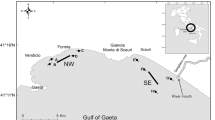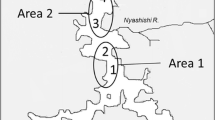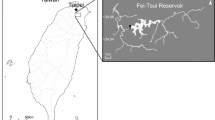Abstract
The estuarine maximum turbidity zone (MTZ) can be assumed to be a stressful environment featuring special conditions of great biological importance with an excess of organic matter, high-deposition rates, large variations in salinity, and dredging activities. Under such harsh conditions, populations may remain below the carrying capacity and competition is assumed to be of little importance, as predicted by the stress-gradient hypothesis. Therefore, we hypothesized that invertebrates of similar feeding types may utilize the same resources. To test our hypothesis, we chose the three most abundant taxa classified in literature as deposit feeders (Bathyporeia pilosa, Boccardiella ligerica, Marenzelleria sp.) and two taxa classified as predominately predacious (Palaemon longirostris, Crangon crangon) and determined their isotopic niches based on a stable isotope analysis for the MTZ of the Elbe Estuary (Germany). We expected the isotopic niches of similar feeding types to show a clear overlap if our hypothesis was true. Our results showed that the isotopic niches of no two taxa overlapped within each feeding group, indicating different resource use and the absence of competition. The sediment analysis revealed that two of the deposit feeders inhabited significantly different mean grain sizes. The lack of overlap of isotopic niches within each feeding group may be due to differences in habitat and feeding behavior in the case of the deposit feeders and due to different migration behavior in the case of the predominately predacious species. However, competition may have occurred in the past, resulting in a divergence of feeding niches during evolution.





Similar content being viewed by others
References
Anderson, Caroline, and Gilbert Cabana. 2007. Estimating the trophic position of aquatic consumers in river food webs using stable nitrogen isotopes. Journal of the North American Benthological Society 26(2): 273–285.
Araújo, Márcio S., Daniel I. Bolnick, and Craig A. Layman. 2011. The ecological causes of individual specialisation. Ecology Letters 14(9): 948–958.
Baeta, Alexandra, Rute Pinto, Ivan Valiela, Pierre Richard, Nathalie Niquil, and João C. Marques. 2009. δ15N and δ13C in the Mondego estuary food web: seasonal variation in producers and consumers. Marine Environmental Research 67: 109–116.
Bastrop, Ralf, Matthias Röhner, Christian Sturmbauer, and Karl Jürss. 1997. Where did Marenzelleria spp. (Polychaeta: Spionidae) in Europe come from? Aquatic Ecology 31(2): 119–136.
Batschelet, E. 1981. Circular statistics in biology. London: Academic Press.
Bearhop, Stuart, Colin E. Adams, Susan Waldron, Richard A. Fuller, and Hazel MacLeod. 2004. Determining trophic niche width: a novel approach using stable isotope analysis. Journal of Animal Ecology 73(5): 1007–1012.
Béguer, M., S. Pasquaud, P. Noël, M. Girardin, and P. Boët. 2008. First description of heavy skeletal deformations in Palaemon shrimp populations of European estuaries: the case of the Gironde (France). Hydrobiologia 607(1): 225–229.
Bergemann, Michael. 2004. Die Trübungszone in der Tideelbe - Beschreibung der räumlichen und zeitlichen Entwicklung. FGG Elbe. Magdeburg. http://www.fgg-elbe.de/dokumente/fachberichte.html Accessed 7 April 2016.
Blum, Linda K., and Aaron L. Mills. 2013. Estuarine microbial ecology: in Estuarine Ecology. In , eds. John W. Day Jr., Byron C. Crump, W. Michael Kemp, and Alejandro Yáñez-Arancibia, 235–261. Hoboken: Wiley-Blackwell.
Boehlich, Marcus J., and Thomas Strotmann. 2008. The Elbe Estuary. Die Küste 74: 288–306.
Carstens, Marina, Ulrich Claussen, Michael Bergemann, and Thomas Gaumert. 2004. Transitional waters in Germany: the Elbe estuary as an example. Aquatic Conservation: Marine and Freshwater Ecosystems 14(S1): 81–92.
Cartaxana, Alexandra. 1994. Distribution and migrations of the prawn Palaemon longirostris in the Mira River estuary (southwest Portugal). Estuaries 17(3): 685–694.
Connell, Joseph H. 1980. Diversity and the coevolution of competitors, or the ghost of competition past. Oikos 35: 131–138.
Core Team, R. 2013. R: a language and environment for statistical computing. Vienna: R Foundation for Statistical Computing.
Cummings, David O., Jerome Buhl, Raymond W. Lee, Stephen J. Simpson, and Sebastian P. Holmes. 2012. Estimating niche width using stable isotopes in the face of habitat variability: a modelling case study in the marine environment. PloS One 7(8): e40539.
Dahl, Erik. 1956. Ecological salinity boundaries in poikilohaline waters. Oikos 7(I): 1–21.
Dauer, Daniel M. 1997. Functional morphology and feeding behavior of Marenzelleria viridis (Polychaeta: Spionidae). Bulletin of Marine Science 60(2): 512–516.
Dauer, Daniel M., Catherine A. Maybury, and R. Michael Ewing. 1981. Feeding behavior and general ecology of several spionid polychaetes from the Chesapeake Bay. Journal of Experimental Marine Biology and Ecology 54(1): 21–38.
Dauvin, Jean-Claude, and Nicolas Desroy. 2005. The food web in the lower part of the Seine estuary: a synthesis of existing knowledge. Hydrobiologia 540(1–3): 13–27.
Dauvin, Jean-Claude, and Thierry Ruellet. 2009. The estuarine quality paradox: is it possible to define an ecological quality status for specific modified and naturally stressed estuarine ecosystems? Marine Pollution Bulletin 59(1–3): 38–47.
DeNiro, Michael J., and Samuel Epstein. 1978. Influence of diet on the distribution of carbon isotopes in animals. Geochimica et Cosmochimica Acta 42(5): 495–506.
Doi, H., M. Matsumasa, T. Toya, N. Satoh, C. Mizota, Y. Maki, and E. Kikuchi. 2005. Spatial shifts in food sources for macrozoobenthos in an estuarine ecosystem: carbon and nitrogen stable isotope analyses. Estuarine, Coastal and Shelf Science 64(2–3): 316–322.
Elliott, M., and D.S. McLusky. 2002. The need for definitions in understanding estuaries. Estuarine, Coastal and Shelf Science 55(6): 815–827.
Elliott, Michael, and Victor Quintino. 2007. The estuarine quality paradox, environmental homeostasis and the difficulty of detecting anthropogenic stress in naturally stressed areas. Marine Pollution Bulletin 54(6): 640–645.
Folk, R.L., and W.C. Ward. 1957. Brazos River bar: a study in the significance of grain size parameters. Journal of Sedimentary Petrology 27(1): 3–26.
Fry, Brian, and Connie Arnold. 1982. Rapid 13C/12C turnover during growth of brown shrimp (Penaeus aztecus). Oecologia 54(2): 200–204.
Gilbert, Eliandro Ronael, Mauricio Garcia de Camargo, and Leonardo Sandrini-Neto. 2012. rysgran: Grain size analysis, textural classifications and distribution of unconsolidated sediments.
Giraudoux, Patrick. 2014. pgirmess: Data analysis in ecology.
González-Ortegón, Enrique, José A. Cuesta, Emilio Pascual, and Pilar Drake. 2010. Assessment of the interaction between the white shrimp, Palaemon longirostris, and the exotic oriental shrimp, Palaemon macrodactylus, in a European estuary (SW Spain). Biological Invasions 12(6): 1731–1745.
Grant, P.R., B.R. Grant, J.N. Smith, I.J. Abbott, and L.K. Abbott. 1976. Darwin’s finches: population variation and natural selection. Proceedings of the National Academy of Sciences 73(1): 257–261.
Hartmann-Schröder, G. 1996. Polychaeta. Annelida, Borstenwürmer - Die Tierwelt Deutschlands vol. 58. Jena: Gustav Fischer.
Hempel, Christine. 1957. Über den Röhrenbau und die Nahrungsaufnahme einiger Spioniden (Polychaeta sedentaria) der deutschen Küsten. Helgoländer Wissenschaftliche Meeresuntersuchungen 6(1): 100–135.
Hollander, Myles, and Douglas A. Wolfe. 1973. Nonparametric statistical methods. New York: John Wiley and Sons.
Hutchinson, George Evelyn. 1957. Concluding remarks. Cold Spring Harbor Symposia on Quantitative Biology 22: 415–427.
Jackson, Andrew L., Richard Inger, Andrew C. Parnell, and Stuart Bearhop. 2011. Comparing isotopic niche widths among and within communities: SIBER—Stable Isotope Bayesian Ellipses in R. The Journal of Animal Ecology 80(3): 595–602.
Jackson, Michelle C., Ian Donohue, Andrew L. Jackson, J. Robert Britton, David M. Harper, and Jonathan Grey. 2012. Population-level metrics of trophic structure based on stable isotopes and their application to invasion ecology. PloS One 7(2): e31757.
Jardine, Timothy D., R. Allen Curry, Kristie S. Heard, and Richard A. Cunjak. 2005. High fidelity: isotopic relationship between stream invertebrates and their gut contents. Journal of the North American Benthological Society 24(2): 290–299.
Kappenberg, Jens, and Iris Grabemann. 2001. Variability of the mixing zones and estuarine turbidity maxima in the Elbe and Weser estuaries. Estuaries 24(5): 699–706.
Lawlor, L.R. 1980. Overlap, similarity, and competition coefficients. Ecology 61(2): 245–251.
Layman, Craig A. 2007. What can stable isotope ratios reveal about mangroves as fish habitat? Bulletin of Marine Science 80(3): 513–527.
Layman, Craig A., Marcio S. Araujo, Ross Boucek, Caroline M. Hammerschlag-Peyer, Elizabeth Harrison, Zachary R. Jud, Philip Matich, Adam E. Rosenblatt, Jeremy J. Vaudo, Lauren A. Yeager, David M. Post, and Stuart Bearhop. 2012. Applying stable isotopes to examine food-web structure: an overview of analytical tools. Biological Reviews 87(3): 545–562.
Little, Colin. 2000. The biology of soft shores and estuaries. New York: Oxford University Press.
Lloyd, A.J., and C.M. Yonge. 1947. The biology of Crangon vulgaris L. in the Bristol Channel and Severn Estuary. Journal of the Marine Biological Association of the United Kingdom 26(04): 626–661.
Marchand, Jocelyne. 1981. Observations sur l’écologie de Crangon crangon (Linné) et Palaemon longirostris H. Milne Edwards (Crustacea, Decapoda, Natantia). Vie et Milieu 31(1): 83–92.
May, R.M. 2006. Network structure and the biology of populations. Trends in Ecology and Evolution 21(7): 394–399.
McCarthy, L.C., W.F. Loftus, and J.S. Rehage. 2012. Segregation of palaemonid shrimp along an Everglades estuarine gradient: do multiple species have similar trophic function? Bulletin of Marine Science 88(4): 843–861.
McKinney, C.R., J.M. McCrea, S. Epstein, H.A. Allen, and H.C. Urey. 1950. Improvements in mass spectrometers for the measurement of small differences in isotope abundance ratios. Review of Scientific Instruments 21(8): 724–730.
McLusky, D.S., and M. Elliott. 2004. The estuarine ecosystem. Ecology, threats and management. Oxford: Oxford University Press.
Menge, Bruce A., and John P. Sutherland. 1987. Community regulation: variation in disturbance, competition, and predation in relation to environmental stress and recruitment. The American Naturalist 130(5): 730–757.
Middelburg, Jack J., and Peter M.J. Herman. 2007. Organic matter processing in tidal estuaries. Marine Chemistry 106(1–2): 127–147.
Miller, Douglas C., Michael J. Bock, and Elizabeth J. Turner. 1992. Deposit and suspension feeding in oscillatory flows and sediment fluxes. Journal of Marine Research 50: 489–520.
Minagawa, Masao, and Eitaro Wada. 1984. Stepwise enrichment of 15N along food chains: further evidence and the relation between δ15N and animal age. Geochimica et Cosmochimica Acta 48(5): 1135–1140.
Newsome, Seth D., Carlos Martinez del Rio, Stuart Bearhop, and Donald L. Phillips. 2007. A niche for isotopic ecology. Frontiers in Ecology and the Environment 5(8): 429–436.
Oh, Chul-Woong, Richard G. Hartnoll, and Richard D.M. Nash. 2001. Feeding ecology of the common shrimp Crangon crangon in Port Erin Bay, Isle of Man, Irish Sea. Marine Ecology Progress Series 214: 211–223.
Parnell, Andrew, and Andrew Jackson. 2013. siar: stable isotope analysis in R.
Peterson, Bruce J. 1999. Stable isotopes as tracers of organic matter input and transfer in benthic food webs: a review. Acta Oecologica 20(4): 479–487.
Polis, Gary A., Wendy B. Anderson, and Robert D. Holt. 1997. Toward an integration of landscape and food web ecology: the dynamics of spatially subsidized food webs. Annual Review of Ecology and Systematics 28: 289–316.
Post, David M. 2002. Using stable isotopes to estimate trophic position: models, methods and assumptions. Ecology 83(3): 703–718.
Quevedo, Mario, Richard Svanbäck, and Peter Eklöv. 2009. Intrapopulation niche partitioning in a generalist predator limits food web connectivity. Ecology 90(8): 2263–2274.
Riedel-Lorjé, Jeannette Cornelie, Nico Möller-Lindenhof, and Bernd Vaessen. 1992. Salzgehalts- und Trübstoffverhältnisse in dem oberen Brackwassergebiet der Elbe. Kiel, Hannover, Hamburg. http://www.fgg-elbe.de/dokumente/fachberichte.html Accessed 7 April 2016.
Rogers, Karyne M. 1999. Effects of sewage contamination on macro-algae and shellfish at Moa point, New Zealand using stable carbon and nitrogen isotopes. New Zealand Journal of Marine and Freshwater Research 33(2): 181–188.
Ryan, C., B. McHugh, C.N. Trueman, R. Sabin, R. Deaville, C. Harrod, S.D. Berrow, and I. O’Connor. 2013. Stable isotope analysis of baleen reveals resource partitioning among sympatric rorquals and population structure in fin whales. Marine Ecology Progress Series 479: 251–261.
Schoener, Thomas W. 1971. Theory of feeding strategies. Annual Review of Ecology and Systematics 2: 369–404.
Schoer, J.H. 1990. Determination of the origin of suspended matter and sediments in the Elbe Estuary using natural tracers. Estuaries 13(2): 161–172.
Schwedhelm, E., W. Salomons, J. Schoer, and H.D. Knauth. 1988. Provenance of the sediments and the suspended matter of the Elbe estuary. GKSS 88/E/20. Geesthacht: GKSS-Forschungszentrum Geesthacht.
Siegel, Sidney, and N. John Castellan Jr. 1988. Non parametric statistics for the behavioural sciences. New York: MacGraw Hill.
Taupp, Thomas, and Markus A. Wetzel. 2013. Relocation of dredged material in estuaries under the aspect of the water framework directive—a comparison of benthic quality indicators at dumping areas in the Elbe estuary. Ecological Indicators 34: 323–331.
Taupp, Thomas, and Markus A. Wetzel. 2014. Leaving the beaten track—approaches beyond the Venice System to classify estuarine waters according to salinity. Estuarine, Coastal and Shelf Science 148: 27–35.
Törnroos, Anna, and Erik Bonsdorff. 2012. Developing the multitrait concept for functional diversity: lessons from a system rich in functions but poor in species. Ecological Applications 22(8): 2221–2236.
Vieira, J.P., and J.P. Castello. 1997. Environment and biota of the Patos Lagoon estuary—fish fauna—in subtropical convergence marine ecosystem: the coast and the sea in the warm temperate southwestern Atlantic. In , eds. U. Seeliger, C. Odebrecht, and J.P. Castello. New York: Springer.
Wetzel, Markus A., Peter C. von der Ohe, Werner Manz, Jochen H.E. Koop, and Dierk-Steffen Wahrendorf. 2012. The ecological quality status of the Elbe estuary: a comparative approach on different benthic biotic indices applied to a highly modified estuary. Ecological Indicators 19: 118–129.
Wetzel, Markus A., Dierk-Steffen Wahrendorf, and Peter C. von der Ohe. 2013. Sediment pollution in the Elbe estuary and its potential toxicity at different trophic levels. Science of the Total Environment 449: 199–207.
Wilson, James J., and John W. Fleeger. 2013. Estuarine benthos. In Estuarine Ecology, eds.John W. Day Jr., Byron C. Crump, W. Michael Kemp, and Alejandro Yáñez-Arancibia, 303–325. Hoboken: Wiley-Blackwell.
Ysebaert, Tom, Liesbeth de Neve, and Patriek Meire. 2000. The subtidal macrobenthos in the mesohaline part of the Schelde Estuary (Belgium): influenced by man? Journal of the Marine Biological Association of the United Kingdom 80: 587–597.
Vander Zanden, M. Jake, and Joseph B. Rasmussen. 1999. Primary consumers δ13 C and δ15 N and the trophic position of aquatic consumers. Ecology 80(4): 1395–1404. doi:10.1890/0012-9658(1999)080[1395:PCCANA]2.0.CO;2
Vander Zanden, M. Jake, and Joseph B. Rasmussen. 2001. Variation in δ15 N and δ13 C trophic fractionation: implications for aquatic food web studies. Limnology and Oceanography 46(8): 2061–2066. doi:10.4319/lo.2001.46.8.2061
Acknowledgments
Our thanks go to the crew of the vessel ‘MS Vogelsand’ for their help with sampling and to Bernd Vaessen from the Waterways and Shipping Office in Cuxhaven for his help with organizing the cruise. We would also like to express our gratitude to the biologists on board Jörn Reichert, Arnd Krumwiede, Nike Peschel, and Ester Bruns for their help with sampling, species sorting, and determination during the cruise. We would also like to thank Jeremy Wilkinson and Amanda Habbershaw for linguistic suggestions. Furthermore, the constructive comments of three anonymous reviewers were greatly appreciated.
Author information
Authors and Affiliations
Corresponding author
Additional information
Communicated by Carolyn A. Currin
Electronic supplementary material
ESM 1
(PDF 698 kb)
Rights and permissions
About this article
Cite this article
Taupp, T., Hellmann, C., Gergs, R. et al. Life Under Exceptional Conditions—Isotopic Niches of Benthic Invertebrates in the Estuarine Maximum Turbidity Zone. Estuaries and Coasts 40, 502–512 (2017). https://doi.org/10.1007/s12237-016-0163-4
Received:
Revised:
Accepted:
Published:
Issue Date:
DOI: https://doi.org/10.1007/s12237-016-0163-4




